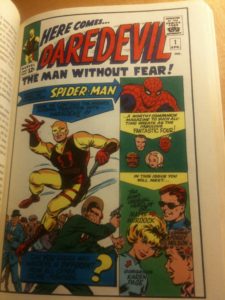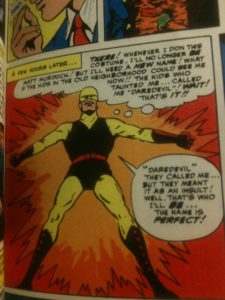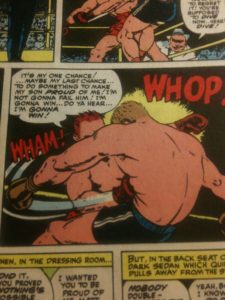There’s no two ways about it: my love of Marvel Comics comes directly from two sources: ORIGINS OF MARVEL COMICS and SON OF ORIGINS OF MARVEL COMICS. These two 1970s collections of the premiere issues of Marvel’s characters served as my introduction to the Marvel Universe, and in no more formative way than in the case of the Man Without Fear, Daredevil.
You see, the best thing about these books, (other than the introductions for each chapter by Stan Lee detailing the creation of the characters and giving a behind-the-scenes glance at Marvel in the Silver Age) was that for each character, you actually got two stories: the origin, and then an issue from much later in the character’s run, to show how the concept had developed over time. And the Daredevil examples were the best of the bunch.
You started off with Daredevil #1 by Stan and Bill Everett, a by-the-numbers Silver Age origin if there ever was one, but in a very stark, almost brittle style by Bill Everett, very unlike the Kirby and Ditko looks one would come to associate with Marvel.
Not that that was a negative. Everett’s scratchier style really makes the story stand out, especially with its grittier origin involving Matt’s prizefighter father being murdered by gangsters.
But the follow-up story was a revelation: “Brother, Take My Hand,” from DAREDEVIL #47, by Stan and the great Gene Colan.
The tale of Willie Lincoln, a Black Vietnam vet and former NYPD officer who returns from the war blind and seeks Matt Murdock’s help in defending him from a bribery frame-up, “Brother” was my first exposure to the work of Gene Colan, and it’s an example of a master at the top of his game. Colan’s approaches to layout were like nothing else you were seeing at Marvel at the time. For example, look at this single-panel shot of Daredevil entertaining the troops at a USO show:
Even this panel of Matt Murdock meeting with his new client has a dynamic feel.
Colan’s facility with acting and expression was also first-rate. Take a look at this scene of Matt Murdock cross-examining mob boss Biggie Benson:
And as for action, Colan could do that better than anyone, and always gave it an innovative twist, such as his use of shadow in this scene in which Murdock fights Biggie’s goons in a dark room, hoping to convince them that he’s Lincoln.
As great as the art was, the story was just as strong, with Stan really taking an opportunity for a change of pace with a bit of courtroom drama, while also trying to make a bit of a statement; as Stan himself says in SON OF ORIGINS, “I admit it…I was trying to really say something in this story, and to say it softly.”
Maybe that’s why the current back-to-basics Mark Waid run is striking such a chord with me. As much as I love the gritty Miller and Brubaker work, for me, DAREDEVIL is always going to be about a man trying to help his fellow man.









Comments are closed.